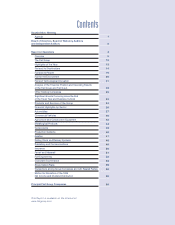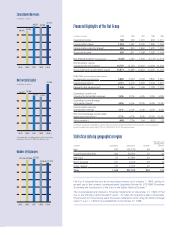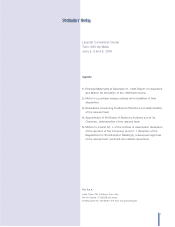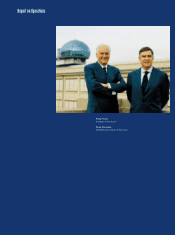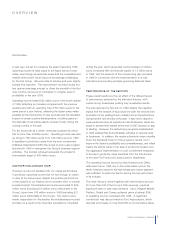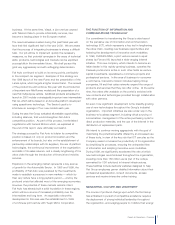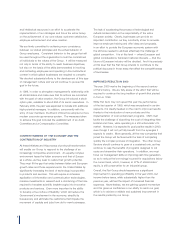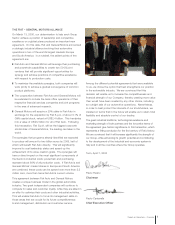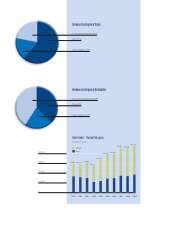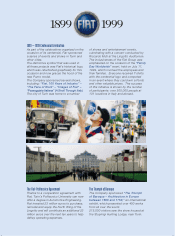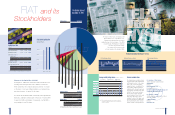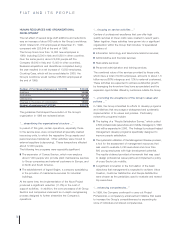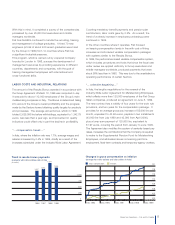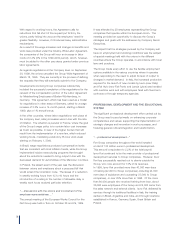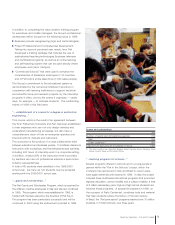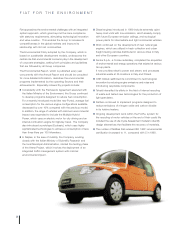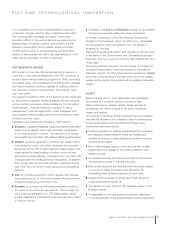Chrysler 1999 Annual Report Download - page 12
Download and view the complete annual report
Please find page 12 of the 1999 Chrysler annual report below. You can navigate through the pages in the report by either clicking on the pages listed below, or by using the keyword search tool below to find specific information within the annual report.
Being a
Group
Value
Creation
Achieving
competitive
excellence
Focusing and
motivating
management
Innovating our products
Reducing complexity
Lengthening the
value chain
Globalizing our activities
Focusing on our
core businesses
Enhancement of
human resources
Customer satisfaction
VALUES STRATEGIES
1 –
Paolo Annibaldi,
Corporate Senior Vice President External Relations and Communication Fiat S.p.A
.
2 – Giancarlo Boschetti, Chief Executive Officer Iveco N.V.
3 – Paolo Cantarella, Chief Executive Officer Fiat S.p.A.
4 – Damien Clermont, Chief Financial Officer Fiat S.p.A.
5 – Luca Cordero di Montezemolo, Chairman and Chief Executive Officer Ferrari S.p.A.
6 – Pier Luigi Fattori, Corporate Senior Vice President Human Resources Fiat S.p.A.
7 – Paolo Fresco, Chairman Fiat S.p.A.
8 – Carlo Gatto, Chief Administration Officer Fiat S.p.A.
9 – Francesco Paolo Mattioli, Executive Vice President Fiat S.p.A.
10 – Paolo Monferino, Executive Vice President Fiat S.p.A.
11 – Umberto Quadrino, Co-Chairman CNH Global N.V.
12 – Jean Pierre Rosso, Chairman and Chief Executive Officer CNH Global N.V.
13 – Roberto Testore, Chief Executive Officer Fiat Auto S.p.A.
1
7
2
8
3
9
4
10
5
11
6
12 13
The Management
Main acquisitions/agreements strengthening the Group competitiveness
Lengthening
Leadership Globalization the value chain
Fiat Auto Joint venture with Yuejin Motor Company (China) ●
Set up of Fiat Auto Egypt Industrial ●
Strategical industrial alliance with General Motors ● ● ●
Iveco Acquisition of a majority interest in Fraikin (France) ●
CNH Global Acquisition of a majority interest in Case Corporation (United States) ● ● ●
Teksid Acquisition of a majority interest in Meridian Technologies (magnesium) ● ●
Magneti Marelli Joint venture with Bosch (lighting) ●
Acquisition Seima Group (lighting) ●
Comau Acquisition Pico Group (United States) ● ●
Acquisition of a majority interest in Renault Automation (France) ● ●
Acquisition of Sciaky activities (France) ●
Toro Assicurazioni Acquisition of the French operations of the Guardian Group ●
THE
FIAT
10
Established in 1899, Fiat was one of the founders
of the European automobile industry. Since its
inception, the Company followed a two-prong
growth strategy — penetration of foreign markets
and focus on innovation — which characterized its
subsequent development and translated into the
manufacturing of high-tech quality products and
the adoption of the most innovative industrial and
organizational systems.
Fiat is a lot more than just cars. The Company
leveraged its expertise in an original and perhaps
unique way among international groups, expanding
its mission to include every area of mobility: from
cars to aircraft, from trucks to trains, from farm
tractors to marine engines and, in more recent
years, even space launchers. Fiat’s industrial
diversification continued at an increasingly rapid
pace, with a growing presence in metallurgical
products and components, followed later on by
production systems, insurance and support
services.
15% Services (*)
85% Industrial
activities
(*) It includes the following service activities operated by the Industrial
Sectors: financial, insurance and mobility services supplied by Fiat Auto,
Iveco and CNH Global; Magneti Marelli’s quick-service centers and infomobility
services; Comau’s plant maintenance operations, etc.
Revenues by Sector
Commercial Vehicles (14%)
Agricultural and
Construction
Equipment (10%)
Other Industrial
Sectors (17%)
Other companies (4%)
Automobiles (45%)
Insurance (7%)
Ferrari and Maserati (2%)
Publishing and Communications (1%)
Metallurgical Products (3%)
Components (7%)
Production Systems (3%)
Aviation (3%)
Rolling Stock and Railway Systems (1%)
Service Sectors (8%)
creating increasingly complex competitive challenges. In its endeavors, it is bolstered by the values it has
consistently applied over its one-hundred-year history and which will guide it into the future: value creation,
customer satisfaction, and the enhancement of its human resources.
This approach is dictated by the pursuit of a specific goal: the achievement of competitive excellence, which
means the attainment of a leadership position in those markets where the Group chooses to operate.
To translate these values into concrete actions, the Company is committed to fully implementing its strategies:
focusing on its core businesses, globalizing its activities, lengthening the value chain and innovating its products.
The Fiat Group is pursuing aggressively all these main avenues of growth. Its commitment is demonstrated
by the major acquisitions and alliances it has concluded, the increasingly balanced geographic mix of its
revenues, the expanding range of its services, the streamlining of its organization, and the successful launch
of new products.
During its long history, Fiat has often been ahead of its time, anticipating trends and repeatedly transforming
itself in an effort to seize every available growth opportunity. The Company has chosen to go down this road
once again, as it continues the journey and the industrial adventure it started in Turin over a century ago.
Fiat was the main force behind the development of a mass
automobile market in Italy, driving the expansion of the national
economy and contributing to the enhancement of its
competitive position in Europe and the rest of the world. This
was particularly true in Southern Italy, where Fiat stimulated
economic growth with the construction of one of its biggest
manufacturing hubs.
The Group also provided a significant contribution to the
economic expansion of emerging countries, where the
Company used the expertise it developed with its early
automotive ventures to implement its overall growth strategy.
Fiat entered the second century of its life against the backdrop
of a profound transformation that is reshaping industry and
GROUP


